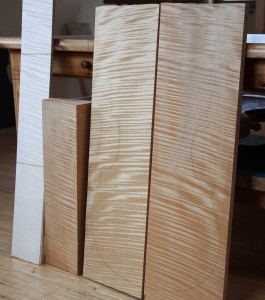My high school English teacher would be so proud…I didn’t end a sentence with a preposition when writing the title for this blog post. The question I hear most often when talking about the construction of a violin (viola/cello/bass) is “What is it made from?”
The short answer is “wood”…but what kind of wood? The top (or table, or front) of the instrument is most often made from spruce. Spruce is incredibly strong for its weight. If you ever get a chance to hold just the top of a violin, you will likely be amazed by how little it weighs. The top needs to be strong and light so that it can support the pressure of the bridge (helped by the bass bar and sound post) and transmit the vibrations from the strings. The ribs (or sides) of the violin are almost always made from maple. The back is also made of maple. The neck is most often carved from maple as well. Maple is a strong, durable wood that also has ideal acoustical properties for the task.
Maple also comes in many varieties of “figure”. The striping, or quilting, or birds-eye figure in maple is highly sought after by makers of musical instruments. In the picture below, you can see the striking striping in the maple. This is often called “flame”, “tiger stripe”, or “fiddleback” figure. The wood in the picture is slated to be used for a cello I will pick up from the maker next summer. I’ll be sure to post a picture of it once it’s varnished and shaped like a cello!


Recent Comments